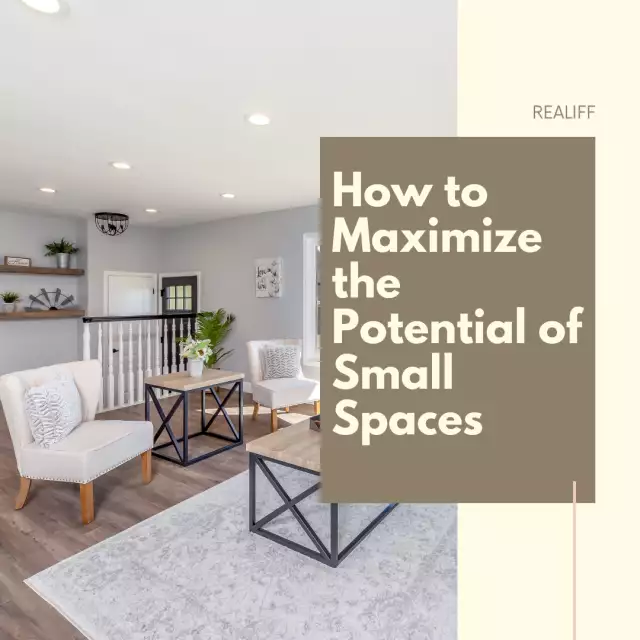Maximizing the Potential of Small Spaces: Strategies for Efficient Utilization
Maximizing the Potential of Small Spaces: Strategies for Efficient Utilization
Small spaces can pose unique challenges when it comes to design and functionality. However, with thoughtful planning and strategic choices, you can transform even the most compact areas into highly functional and aesthetically pleasing spaces. This article will provide you with a comprehensive guide on how to maximize the potential of small spaces, allowing you to make the most of every square inch.
Embrace Minimalism:Adopting a minimalist approach is crucial for small spaces. Declutter and prioritize essential items while eliminating unnecessary furniture or decor. Streamlined and clean aesthetics will create an illusion of spaciousness.
Utilize Vertical Space:Make use of vertical space by installing tall shelves, cabinets, or wall-mounted storage units. This helps to free up valuable floor space and provides ample storage for various items.
First questions to ask any agent during an interview
Multi-functional Furniture:Invest in multi-functional furniture pieces that serve dual purposes. For example, choose a sofa bed, an ottoman with hidden storage, or a dining table that can be folded or extended when needed. These versatile options optimize space utilization.
Clever Storage Solutions:Explore creative storage solutions to maximize space efficiency. Consider under-bed storage containers, hanging organizers, wall-mounted hooks, and built-in shelves. Utilizing every nook and cranny will help keep your space organized and clutter-free.
Smart Room Dividers:In an open-concept layout, use room dividers strategically to create separate zones without sacrificing the sense of openness. Opt for options like sliding doors, curtains, or bookshelves that act as partitions while preserving the flow of light.
Mirror Magic:Integrate mirrors into your small space to create an illusion of depth and reflect natural light. Placing mirrors strategically can visually expand the room and make it feel more spacious.
Owning a Home and The Hidden Costs
Light and Bright Color Schemes:Choose light and neutral color schemes to make your small space appear larger and airier. Light-colored walls, furniture, and flooring help reflect light and create an open atmosphere.
Optimize Natural Light:Maximize natural light by keeping windows uncovered or using sheer curtains. Natural light not only enhances the sense of space but also uplifts the overall ambiance of your small space.
Flexible and Portable Solutions:Consider flexible and portable furniture options that can be easily rearranged or stored away when not in use. Folding chairs, stackable stools, and lightweight tables can adapt to different needs and save space.
Think Outside the Box:Be innovative and explore unconventional ideas to make the most of your small space. Consider utilizing vertical gardens, wall-mounted desks, or convertible workspaces to optimize functionality without sacrificing style.
Owning a Home and The Hidden Costs
Conclusion
Small spaces offer immense potential when approached with creativity and practicality. By embracing minimalism, utilizing vertical space, investing in multi-functional furniture, and implementing smart storage solutions, you can maximize the functionality and aesthetics of your small space. Remember to prioritize organization, light, and neutral colors, and think outside the box to create a comfortable and visually appealing environment that optimizes every square inch.
Q&As
Q: How can I make a small bedroom feel more spacious?
A: To make a small bedroom feel more spacious, start by decluttering and keeping only essential items. Utilize vertical space with tall shelves or wall-mounted storage units. Opt for a bed with built-in storage or under-bed storage containers. Use light-colored paint or wallpaper to create an open and airy atmosphere. Mirrors can also be strategically placed to reflect light and create the illusion of a larger space.
Q: What are some space-saving ideas for a small kitchen?
A: In a small kitchen, maximize storage by installing wall-mounted shelves or cabinets. Utilize the space above cabinets or appliances for additional storage. Hang pots, pans, and utensils on a wall-mounted rack, or use magnetic strips. Consider compact appliances or built-in options to save counter space. Folding or extendable tables and chairs can provide dining space when needed but can be easily stored away when not in use.
Q: How can I create a functional workspace in a small living room?
A: To create a functional workspace in a small living room, consider utilizing a compact desk or a wall-mounted foldable desk. Opt for a chair that can be easily tucked away when not in use. Use vertical space for storage by adding shelves or floating wall organizers. Ensure good lighting with task lamps or natural light. Use room dividers or curtains to separate the workspace from the rest of the living area, providing a dedicated and organized environment.
Q: What lighting options work best for small spaces?
A: Natural light is the best option for small spaces as it creates an open and spacious feel. Keep windows uncovered or use sheer curtains to maximize the amount of natural light entering the room. Supplement natural light with well-placed artificial lighting. Use a combination of ambient, task, and accent lighting to create layers of light and enhance the ambiance. Wall sconces, pendant lights, or recessed lighting can be great options for small spaces, as they save floor and surface space.
Q: How can I visually expand a small bathroom?
A: To visually expand a small bathroom, choose light and neutral colors for walls, tiles, and fixtures. Use large mirrors to create the illusion of depth and reflect light. Opt for a glass shower enclosure or a transparent shower curtain to maintain an open feel. Install good lighting, including task lighting around the vanity area. Utilize vertical space with wall-mounted shelves or cabinets to keep the floor area free and open. Avoid excessive clutter and keep the bathroom well-organized.








